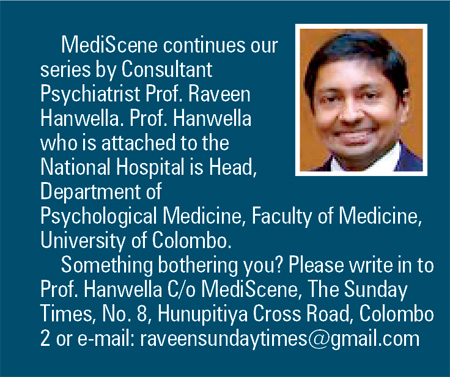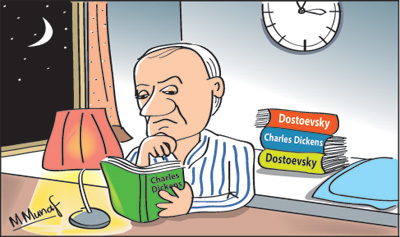Beating your fears: Do something you like to do
View(s):Once when Erickson was in Milwaukee he was asked to see his aunt who lived nearby. She was wealthy, very religious and a regular churchgoer. Erickson found her to be very depressed. An ordinary psychiatrist would have immediately started her on antidepressant medication, but Milton was no ordinary psychiatrist. “On looking around the house I saw three African violets in a potting shed. I told her, I want you to buy every African violet plant in view for yourself, two hundred pots and sprout new African violets. As soon as they are sprouted send one pot for every Christening, every engagement, every wedding and every death in your village.”
 The change was dramatic. She recovered from her depression. “And she became the African Violet Queen of Milwaukee with an endless number of friends. Just that one little interview. I just pointed her in the right direction …. She did all the rest of therapy.”
The change was dramatic. She recovered from her depression. “And she became the African Violet Queen of Milwaukee with an endless number of friends. Just that one little interview. I just pointed her in the right direction …. She did all the rest of therapy.”
What did Erickson do here? He was using a behaviour therapy called activity scheduling where we ask people who are depressed to choose activities which give them pleasure and schedule them into their day. This a standard practice in cognitive behaviour. But Milton the master therapist was able to pinpoint the activity that would bring the greatest benefit for his aunt.
Another time a doctor sought Erickson’s help for his intractable insomnia. He could only fall asleep at 5 a.m. but had to get up by 7 a.m. to go to work. Did Erickson prescribe him sleeping tablets? He did not. Previously, the doctor had told Erickson that he had always wanted to read Dickens and Dostoevsky but never found the time because of his busy medical career. Erickson asked the doctor whether he had a mantelpiece in his house. The doctor answered in the affirmative. Erickson told him, “Fix up a light on your mantelpiece, get a set of Dickens. If you are going to stay awake from 11 to 5 a.m., stay awake standing at the mantelpiece reading Dickens.”
After a few days the doctor asked permission to sit down and said he fell asleep in his chair. “All right,” said Erickson, “Get a clock with an illuminated dial. Go to bed at your usual time and fifteen minutes after you go to bed, if you can read the time on the clock, get up and read Dickens standing at the mantelpiece.” The doctor learned to sleep. He also read the complete works of Dickens and Dostoevsky.
Here we find a unique modifying of the standard behaviour therapy for insomnia named sleep hygiene. We ask the person to use the bedroom for sleeping only and to go to bed at a regular time. If not asleep in 15 minutes the person has to leave the room and engage in some quiet activity such as reading a book. Watching television is not allowed (it is too stimulating). The person can return to the room when sleepy but has to repeat the process if not asleep in 15 minutes. Erickson adds another dimension. He gets the person started on an activity that he would like to do but never found the time for.
Erickson was once consulted by a pianist who had had to stop his music career due to the fear that he would faint when he walked on stage. The pianist had a phobia – an irrational and excessive fear of an object or situation. The standard therapy is graded exposure where the person is exposed in gradual planned steps to the fearful object or situation. Let us see what Erickson did. He told the pianist, “I want you to buy a stack of coloured towels …red, green, blue, flowered and so on. When you get home carefully spread them across the stage floor (the pianist had his own studio at home) and save the last for the piano stool. Send out invitations for a concert and have the room filled. When you come on stage, stop and look at the first towel… do you want to faint on the first towel…or would you prefer to faint on the next one.”
 Erickson then goes on to describe what happened. “So he moved on from towel to towel wondering whether to faint on this one or the next one until he got to the piano stool. He knew it would be awkward to faint on it, so he sat on it. He considered fainting on the piano, but that was awkward too. So he played his concert. He has been playing as a concert pianist since.”
Erickson then goes on to describe what happened. “So he moved on from towel to towel wondering whether to faint on this one or the next one until he got to the piano stool. He knew it would be awkward to faint on it, so he sat on it. He considered fainting on the piano, but that was awkward too. So he played his concert. He has been playing as a concert pianist since.”
The final case I will look at is one of Erickson’s most remarkable where he turned around a person’s life in one session. “I was once asked to lecture in Boston State Hospital on hypnosis. I wanted to find a suitable subject in preparation for my talk and selected a pretty young nurse. You know how pretty subjects are easier to look at… The organisers were shocked… They told me she was suicidal and had been in therapy for years for depression without improvement.”
Erickson was determined to go ahead and after a short lecture on hypnosis asked the nurse Kim to come on stage and placed her in a hypnotic trance. “I took her to the Boston Arboretum, the Boston Zoo…Then told her to walk to the beach, look it over…the place for so many happy memories, the place for many future happy memories…in hypnosis time distortion can occur…you can travel hundreds of miles in a second.” Erickson brought her out of the trance, thanked her and wished her goodbye.
That night Kim disappeared. It was assumed that she had committed suicide and Erickson was criticised and accused of being irresponsible. The year was 1957.
In 1972 Erickson got a long distance call. “You may not remember me… I am Kim. After I left the Boston Hospital I joined the Navy. I am happily married with five children… I am working as a nurse… I thought you would like to know.”
Indeed Erickson was relieved to know she was alive. “I gave her a completely new view on life, beauty and life at the zoo, and beauty of past memories and future memories at the beach.” For Erickson looking at the past was a waste of time and much of his therapy was directed at reorienting his patients to the future – a happy future.
I would like to wish all my readers a happy Christmas and New Year. May your future be happy.


